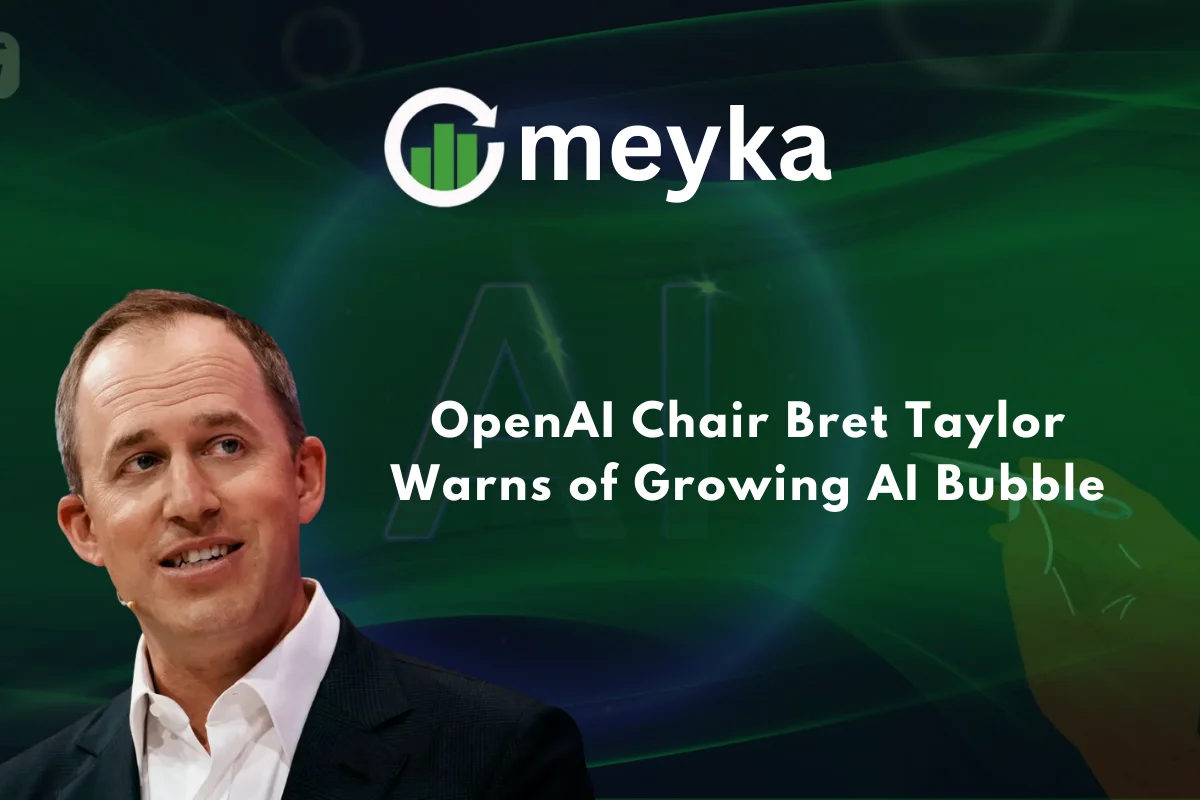OpenAI Chair Bret Taylor Warns of Growing AI Bubble
Artificial intelligence is the hottest topic in the world of technology and finance. Startups are raising billions, investors are chasing AI stocks, and companies are promoting breakthroughs daily. Yet, amid this excitement, Bret Taylor, Chair of OpenAI, has voiced a cautionary note. He believes the industry could be entering a dangerous AI bubble where hype runs ahead of real progress.
Who Is Bret Taylor?
Bret Taylor is a respected name in Silicon Valley. He co-created Google Maps, served as CEO of Salesforce, and played a key role in building some of the most influential platforms of our time.
Now, as Chair of OpenAI, his opinions carry weight across both tech and finance. When someone with his background warns of overvaluation and unsustainable hype, the world pays attention.
What Does the AI Bubble Mean?
A bubble happens when enthusiasm inflates prices far above actual value. In the AI world, we see startups with little revenue raising enormous funds. Stock prices of companies connected to AI are climbing rapidly, often without proven business models to justify such valuations.
Taylor’s warning is not about AI failing. It is about expectations becoming unrealistic. If investors bet too heavily on promises instead of performance, the market could face painful corrections.
The Rise of AI Stocks
AI has become a buzzword in the stock market. From chipmakers to cloud providers, companies are using AI to attract investors. Their stock prices have soared as analysts project exponential growth.
While some companies like Nvidia have strong earnings to back the hype, many smaller firms rely on future potential rather than present results. For investors, this makes stock picking more complex and risky. It highlights the need for careful stock research before buying into AI-related shares.
Why Bret Taylor’s Warning Matters Now
The timing of Taylor’s statement is critical. AI is at the center of business, government, and consumer conversations. Industries are racing to adopt it, and policymakers are scrambling to regulate it.

But not every AI innovation generates revenue. Many projects are experimental, consuming billions in research and infrastructure. If these do not deliver expected profits soon, valuations may crash, taking investors’ money with them. Taylor’s message is simple: growth must be grounded in reality.
Lessons From Past Tech Bubbles
History has seen this story before. During the dot-com bubble in the late 1990s, internet companies with little more than websites saw massive valuations. When the bubble burst, many disappeared, but survivors like Amazon eventually thrived.
The cryptocurrency boom is another example. Prices skyrocketed on speculation, only to collapse when confidence faded. AI could follow a similar path if enthusiasm remains unchecked. Some firms will fail, but the strongest ones will reshape the future.
Opportunities and Risks of AI
Artificial intelligence is not just hype. It is creating real change. In healthcare, AI speeds up diagnoses. In finance, it improves fraud detection and investment analysis. In education, it personalizes learning for students. These are tangible benefits that prove AI’s value.
However, risks cannot be ignored. The cost of developing large AI models is enormous. They require massive computing power and data. Startups without strong financial backing may struggle to survive. This imbalance between cost and revenue is a major factor behind the bubble concerns.
Impact on the Stock Market
The surge in AI investments has made the stock market more volatile. Investors who chase hype without proper stock research may face sudden losses if valuations fall. On the other hand, those who identify companies with solid business strategies can benefit from long-term gains.
AI is shaping the strategies of some of the largest companies in the world. But not every player will succeed. The market will eventually reward those with real applications and penalize those built only on marketing.
What Investors Should Do
Investors should not avoid AI entirely. Instead, they should approach it with balance. The first step is research, understanding which companies have strong earnings, reliable partnerships, and long-term strategies.
Diversification is also crucial. Putting all funds into speculative AI startups is risky. A safer approach is to include a mix of established tech firms, infrastructure providers, and industries that use AI to grow. This strategy reduces risk while still benefiting from the AI wave.
Regulation and the Future of AI
Governments worldwide are considering new rules for AI. These include transparency, ethical use, and accountability. While regulation may slow short-term growth, it could stabilize the industry in the long run.
For investors, regulations may reduce speculative risks by ensuring companies build trustworthy systems. For businesses, clear frameworks may encourage sustainable development rather than hype-driven expansion.
The Road Ahead
AI is here to stay. It will transform industries, economies, and everyday life. Bret Taylor’s warning does not signal the end of AI innovation. Instead, it calls for responsibility.
The coming years will likely see both setbacks and breakthroughs. Some companies will vanish, while others will lead the next technological revolution. The key is patience, careful investment, and realistic expectations.
Conclusion
The AI revolution is real, but so are the risks of overhype. Bret Taylor’s warning about a potential bubble is a reminder that enthusiasm must be balanced with practicality. For investors, businesses, and policymakers, the challenge is to nurture innovation without falling into the trap of inflated expectations.
Artificial intelligence has enormous potential to shape the future. But to ensure lasting success, growth must be sustainable, transparent, and grounded in value.
FAQs
He believes enthusiasm for AI may be inflating valuations too quickly, creating risks for investors and businesses if expectations are not met.
Some are, but not all. Investors must rely on strong stock research to separate solid companies from speculative ones.
Past bubbles like dot-com and crypto show that while many companies fail, those with strong fundamentals often survive and grow stronger.
Disclaimer:
This content is made for learning only. It is not meant to give financial advice. Always check the facts yourself. Financial decisions need detailed research.






